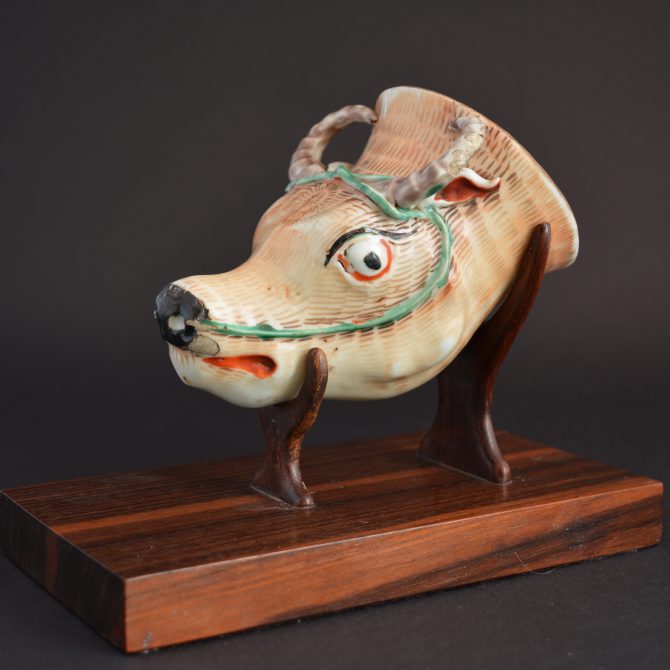
QIANLONG 1736 – 1795 Chinese Porcelain
A Rare 18th Century Chinese Porcelain Rhyton in the Form of an Asian Water Buffalo Bubalus Bubalis. Qianlong Period c.1750 – 1780. With a Later Wood Stand.
SOLD
- Condition
- In good condition, a small section of one horn re-stuck, some minor fritting.
- Size
- Length : 13.5 cm (5 1/4 inches)
- Provenance
- Bluett and Son London (old label to the inside) Sotheby`s New York lot 802 (old label to the inside)
- Stock number
- 24128
- References
- For an Apulian red figure rhyton dating to c.400-300 B.C. in the shape of a bull`s head see http://www.perseus.tufts.edu/Herakles/cattle.html For a very similar rhyton dated to 1725-1730 see : China for the West, Chinese Porcelain & other Decorative Arts for Export Illustrated from the Mottahedeh Collection (David S. Howard and John Ayers, Sotheby`s,1978) Volume II page 583, number 604. Another rhyton of this type, dated to Yongzheng c.1725-1730 is illustrated in : Chinese Export Porcelain in the Reeves Center Collection at Washington and Lee University (Thomas V. Litzenburg Jr. Third Millennium Publishing London 2003. ISBN 1-903942-19-5) page 213, plate 216. Another 18th century Chinese porcelain rhyton cup of this form but undecorated with a white glaze exhibiting a blue green hue is in the Percival David Collection in the British Museum. It is dated 1800-1900. Ref PDF,A.404. It is on display in the gallery and can be viewed on-line. For another Chinese porcelain Rhyton of this model dated to c.1725-1730 see : China for the West, Chinese Porcelain & other Decorative Arts for Export Illustrated from the Mottahedeh Collection (David S. Howard and John Ayers, Sotheby`s,1978) Volume II, page 583, plate 604.
Information
Rhyton :
A rhyton is a container from which fluids were intended to be drunk or to be poured in some ceremony such as libation. The English word rhyton originates in the ancient Greek word ῥυτόν (rhŭtón). The conical rhyton form has been known in the Aegean region since the Bronze Age, or the 2nd millennium BC. However, it was by no means confined to that region. Similar in form to, and perhaps originating from, the drinking horn, it has been widespread over Eurasia since prehistoric times.
Rhyton can be found in China from the Tang (618-907). They were not just made as a ceramic form, indeed the Tang ceramic examples copy jade and metal. The forms differ somewhat from those of the Classical period, they are known in the form of lions, dragons, elephants, ducks and water buffalo. The form would probably have reached China through central Asia. The revival of the rhyton during the 18th century is probably connected with the Chinese love of Chinese antiquities rather than with export porcelain bound for Europe. However, examples found their way to the West, interestingly at just the same time as Europeans were rediscovering their own past and excavated examples of the very first rhyton were being eagerly collected.